Many people, including some who love fishing, might feel nervous about touching catfish because of their reputation for stinging. It’s kind of a love-hate situation, folks adore catching catfish but fear getting stung by them.
So, catching a catfish can either feel like a dream come true or a bit of a nightmare, depending on whether you know how to handle them safely.
That’s where this guide comes into turn your fishing adventure into a positive experience by showing you the ropes on how to hold a catfish.
The aim here is to make things easier for you, ensuring that you feel confident and secure when handling these fish. So, keep reading to discover the tricks and tips that’ll make handling catfish a breeze.
Catfish behavior and anatomy
My experience with holding a catfish was succeeded after having an in-depth knowledge of this specie.
So here are some important point you should keep in mind;
- Holding a catfish is like trying to hold onto something really strong and quick, you need to be ready and have a good grip to keep them secure.
- Also, staying calm and avoiding sudden movements are necessary to keeping these catfish relaxed and at the same time making sure they don’t panic while you’re holding them.
It’s all about understanding their strength and behavior to handle them safely and with respect.
Before moving towards an actual topic of how to hold a catfish, you must be aware of catfish’s anatomy and behavioral approach
Understanding the truth about catfish and their so-called “stings” is essential. It helps anglers learn how to handle these fish safely and dispels any unnecessary fears or misconceptions about their barbels or fins.
Catfish Anatomy- their specialized body:
Catfish are quite different from your typical fish. They’re what we call “bottom feeders,” meaning they like to hang out at the bottom of rivers or lakes, searching for food. Because of this unique lifestyle, their bodies are perfectly shaped to fit their environment.
Their bodies have adapted to this bottom-dwelling life. They’re not built like your average fish; instead, they have a distinct body shape that works perfectly for scavenging along the river or lake-bed. This shape helps them root around for food, using their sensitive barbels (those whisker-like things you see) to sense and locate their meals.
Their specialized body shape also comes in handy when it’s time to hold them.
Understanding their anatomy is crucial for handling them properly and safely. Knowing where their spines are and how to avoid them is essential, especially because those spines can pack a painful poke if you’re not careful.
So, when it comes to holding catfish, it’s important to consider their unique body shape and the location of their spines to handle them safely and effectively.
Do Cat Fish Have Spines:
Catfish have sharp fins called “spines” that can cause puncture wounds and hurt you. Their dorsal fins and two pectoral fins are pointed and sharp along their front edges. The spines on their backsides have serrated edges, all posing potential harm.
Smaller catfish, like madtoms, can be especially dangerous as their spines are poisonous. The smaller the catfish, the sharper their spines, making them riskier.
Trophy catfish like channel, blue, and flat-head types typically don’t have poisonous spines, but they might carry bacteria that can cause infections if they puncture your skin.
As catfish age, their spines become less sharp, but it’s wise to remain cautious around them.
Getting cut by catfish spines can be quite painful, depending on the wound’s size. Some anglers describe these cuts as among the worst they’ve experienced while fishing.
It’s important to handle catfish carefully to avoid getting hurt by their sharp spines.
Do all catfish have barbs?
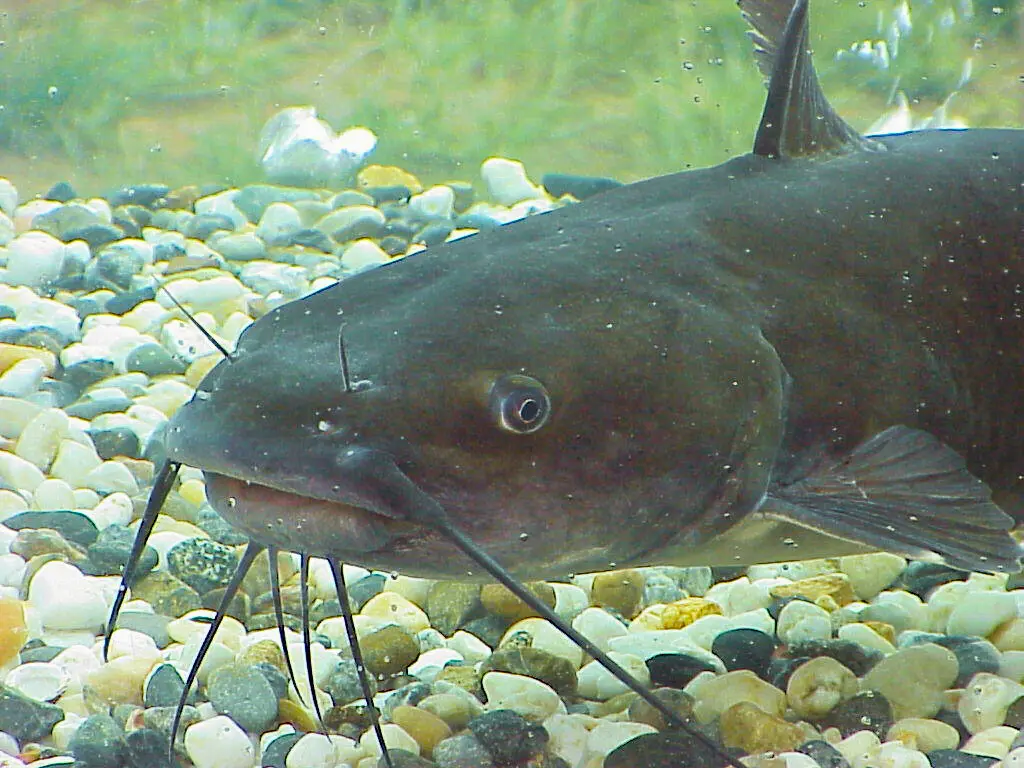
Source: https://en.wikipedia.org/wiki/Catfish
Catfish contain 4 pairs of barbel, nasal, maxillary (present on each side of mouth), and 2 pairs of chin barbels. Barbels are always occur in pairs, although some species may lack certain pairs.
The whiskers on a catfish, often called barbels, are harmless and gentle to touch. They’re quite similar to the whiskers you might find on a dog, soft and flexible. There’s no need to worry about any kind of stinging or harm from these whiskers, they won’t hurt you at all.
However, many larger catfish contain Chemo-receptors at the outer covering of their body, acting like a taste bud, allowing to ‘taste’ anything they touch and smell chemicals in the water.
Catfish have relatively small eyes compared to their body size. The significance of barbels and chemo-reception in detecting food often makes the eyes less important in their feeding strategy
However, when it comes to potential sources of discomfort or injury from a catfish, it’s essential to pay attention to their dorsal and pectoral fins. These fins are situated behind the fish’s head on both sides and along the top of the body, starting from behind the head.
Approaching these fins from behind is generally safe as they are soft. But here’s the crucial part: the front part of these fins, closest to the fish’s head, contains a hard spine that runs the length of the fin. It’s this spine that could potentially cause discomfort or injury if mishandled or if it pricks your skin.
Slimy Coating:
Catfish have this slimy coating on their skin that serves as a protective layer against predators and pesky parasites. This coating is a bit like armor for them.
Remember, this slimy layer also makes them super sensitive to touch. It’s like they’re covered in a protective, sensitive shield.
So, when you’re holding a catfish, it’s crucial to be really gentle with them. Avoid rubbing their skin too hard because that sensitive slime layer can easily get disturbed.
Handling them delicately, gently is important.
Catfish Teeth:
The teeth of catfish are quite unique and differ significantly from traditional, sharp teeth. Instead, they resemble brush bristles and serve the purpose of scraping algae and scum from surfaces like wood and rocks. These teeth are not designed for tearing into prey but rather for a more abrasive, scraping action.
That’s why Catfish have a distinctive approach to feeding, and their teeth are nothing like the sharp, predatory teeth seen in fish like pike or muskie.
Primarily, catfish are detritus eaters, meaning they consume decomposing organic matter. Additionally, they may feed on snails and small fish while actively scavenging dead material
If you ever happen to put your finger in a catfish’s mouth, you’ll feel a rough, sandpaper-like texture due to these teeth. While this might cause minor abrasions on your skin, especially with larger fish, it generally poses little harm beyond that.
Muscular body:
Catfish are pretty impressive creatures. Their bodies are super strong and muscular because they need that strength to swim against strong river currents and stay put on the riverbed. When you’re holding them, it’s essential to get a good grip, otherwise, they might slip right out of your hands and back into the water.
Behavior:
Their behavior is another crucial thing to understand. Catfish are known for being quite aggressive eaters. They’ve got a real knack for finding food, but they can also get easily spooked if they sense danger.
So, when you’re handling these fish, it’s vital to keep calm and avoid sudden movements that might startle them.
Tips for holding Catfish
Before moving towards an actual topic, here are some tips that will be helpful while holding catfish.
TIP 1:
Keep the catfish steady: When holding a catfish, try to keep it calm and avoid letting it wiggle too much. If it starts moving vigorously, those spiky fins can accidentally prick you. So, find a secure hold and keep the catfish as steady as possible to reduce the chances of getting poked.
TIP 2:
Keep the catfish near your body: Keep the catfish close to your body when holding it to stay in control and prevent it from slipping away.
TIP 3:
Consider using a lip grip tool for larger catches: When you’ve got a big catch, using a lip grip tool can be a game-changer. These handy tools latch onto the fish’s lip, giving you a secure hold without needing to touch it directly. This way, you can manage, examine, and safely release the fish without any hands-on contact.
TIP 4:
Use gloves: Consider wearing sturdy gloves when handling catfish to protect your hands from their spines. While they shield you from potential pricks, thicker gloves might make it a bit harder to handle the fish delicately.
TIP 5:
Keep Antiseptic spray and other medications with you: It’s a good idea to have antiseptic spray and hydrocortisone medication like Neosporin with you while fishing. These can be super helpful for treating any small scratches or pokes you might get while handling the fish. They come in handy to prevent infections and soothe those minor injuries on the spot.
TIP 6:
Use net: Using a net can be really handy when handling a catfish, especially if it’s a feisty one. Pick a strong net with wide holes to avoid the fish getting tangled up while you handle it.
How to Hold small Catfish
Handling smaller catfish can be trickier than handling larger ones because their spines can be sharp and cause injury. Even full-grown smaller species like madtoms and bullheads can have spines that stay sharp due to their size. The spines of small channel, flat-head, and blue catfish can also cause painful wounds.
When handling catfish measuring around 12 inches or less, be cautious as these smaller ones are more likely to poke you while they’re flopping on the ground or dangling from your fishing line.
To hold them:
- Quickly grip them around the back of their head.
- Position your thumb and forefinger behind each pectoral fin.
- The crook of your hand between these fingers should rest against the dorsal fin.
This tight grip prevents the fish from escaping, and since the dangerous spines are forward of your hand, you’re less likely to get stung.
Quickly grip them around the back of their head:

When you hold a catfish, wrapping your hand around its backside and positioning the webbing between your thumb and forefinger along the rear edge of the dorsal fin is a smart way to keep safe.
Catfish have spines that extend when they’re out of the water, and that dorsal fin spine acts like a natural barrier, protecting your hand.
Placing your hand behind these spines, rather than in front of them, is safer.
This way, there’s less chance of accidentally bumping into the spines and getting poked, especially if the catfish is still moving around.
Handling a catfish carefully like this helps you avoid getting hurt by those sharp spines.
Position your thumb and forefinger behind each pectoral fin:
When handling a catfish, place your fingers on both sides of the pectoral fins. Hold your hand in a way that your thumb and remaining four fingers point toward the fish’s mouth.
It’s essential to position your fingers just behind the fins to avoid the spines at the front edge. For a more secure grip, if possible, slide your fingers under the fish’s belly and press your fingertips together.
This grip helps you handle the catfish safely and more firmly.
The crook of your hand between these fingers should rest against the dorsal fin:
If you’re having trouble grabbing the catfish from behind, there’s another way to handle it safely. Hold the fish from underneath by covering its belly with your palm. Make sure to position your thumb away from the dorsal spine, creating a safe distance. Then, secure your fingers behind the pectoral spines to prevent any accidental jabbing.
For better control, use your middle and forefinger to pinch the pectoral fin on the opposite side of your thumb. When dealing with a medium-sized catfish that’s harder to manage with one hand, the sturdy bones behind each pectoral fin provide an excellent grip.
How to hold Medium Catfish
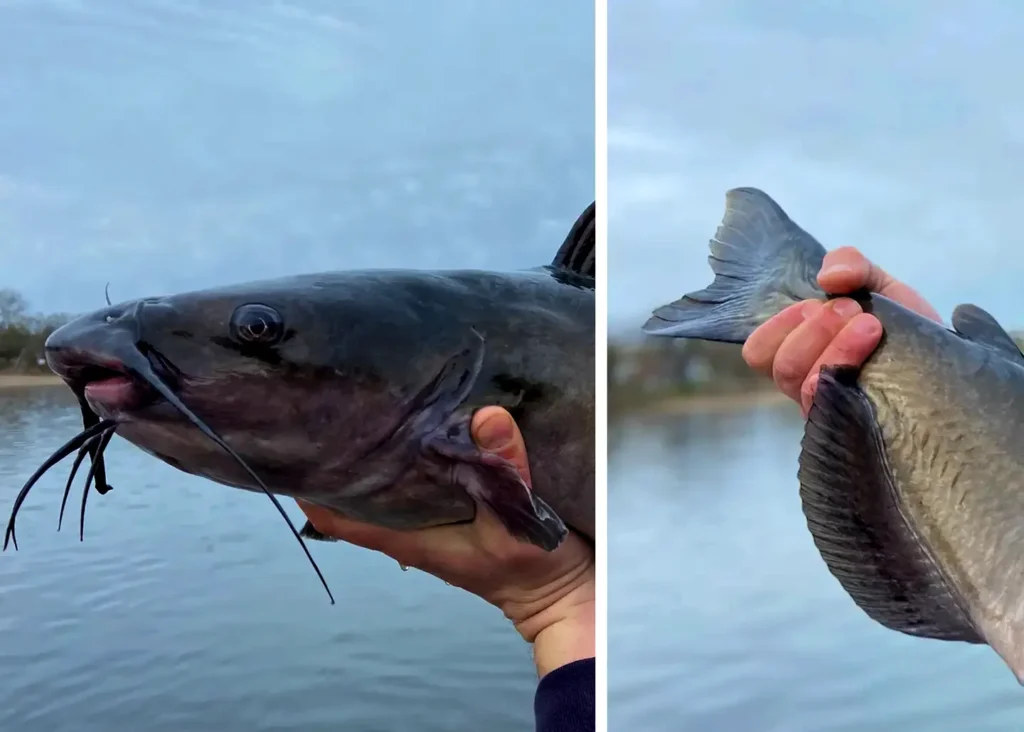
When it comes to handling different sizes of catfish, there are some key things to remember. Even if the bullhead is small, its spines can sting quite a bit. On the other hand, the spines of larger catfish like channels, flat-heads, and blues get thicker and less sharp with age, but they can still cause more damage due to their jagged and splintered ends.
For catfish in the 12 to 24-inch range, while they’re often more photogenic for pictures, handling them requires care.
Instead of gripping them behind the head, a safer method is to support them under the head near the gills.
Use your thumb and index finger for one pectoral fin and your pinky and ring finger for the other. This way, you control the fish but keep the sharp ends away from your hand.
Meanwhile, your other hand can support the base of the tail, which doesn’t have sharp points. This hold provides complete control without worrying about the dorsal spine jabbing you.
Another technique involves placing a thumb firmly behind one pectoral fin and the other pectoral between the index and second finger. Then, grip the tail with your other hand for complete control.
Both methods aim to handle the catfish safely, avoiding the spines while maintaining control of the fish.
How to hold big size catfish
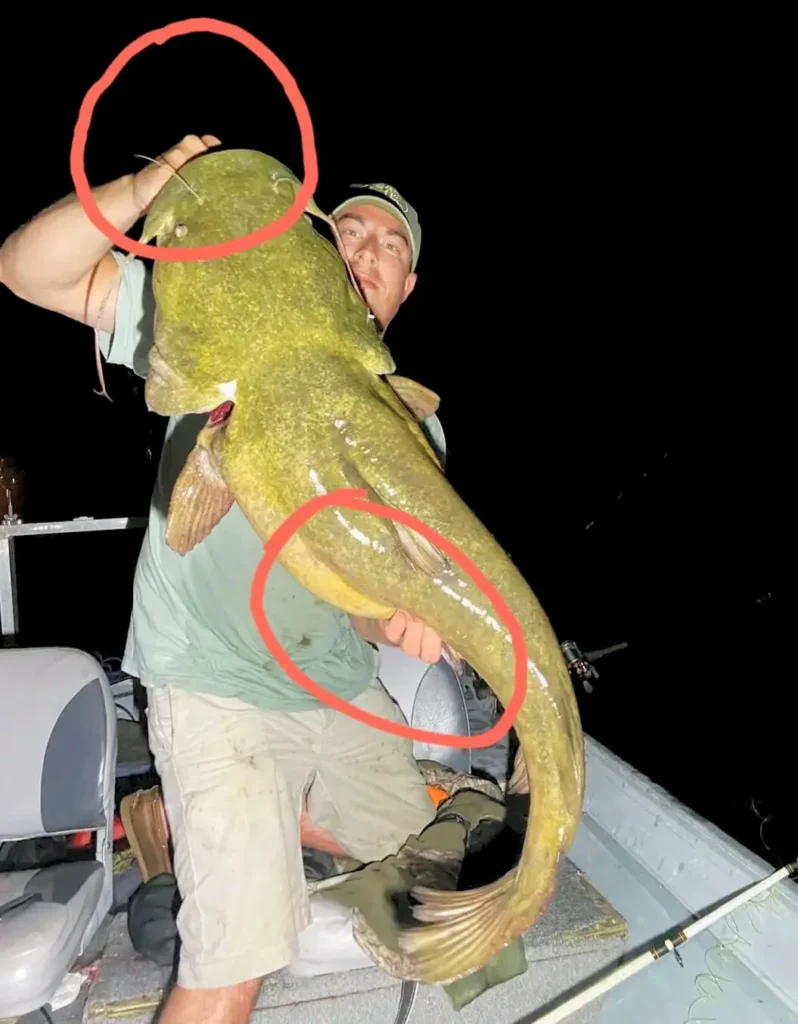
As catfish grow larger, around 10 pounds or more, the risk of getting spine becomes significantly lower. Even massive cats like 80-pound blues or 50-pound flatheads still have spines, but at this size, those spines are usually short, thick, and less sharp.
These catfish types don’t have teeth, but the inside of their mouths might feel rough and slightly sharp, so holding them from mouth and tail is fine.
Additionally, they may be covered by a protective layer of skin. These huge catfish aren’t as prone to sudden movements and contortions as smaller ones, so it’s less likely for their spines to accidentally penetrate your skin unless there’s a very forceful incident.
However,
It’s still not advisable to handle big catfish by their pectoral or dorsal fins. The larger the catfish, the more body surface there is, making it easier to avoid the spines. Large catfish can be handled similarly to medium-sized ones, gripping them behind the head or even by the lower jaw for additional support.
Some people prefer wearing gloves when grabbing the lower lip of a trophy cat, but from personal experience, handling them barehanded for photos or videos isn’t as bad as it may seem.
At most, you might get a bit of skin irritation, almost like a trophy for those who pursue these huge cats.
How to hold a catfish by mouth
Lipping a catfish involves placing your finger inside its mouth and adding some pressure with your thumb on the outside of the lower jaw. However, it’s essential to be cautious because sometimes catfish may attempt to bite. While their bites aren’t typically very painful, they can be uncomfortable.
how to hold and release the Catfish safely
Lift the catfish:
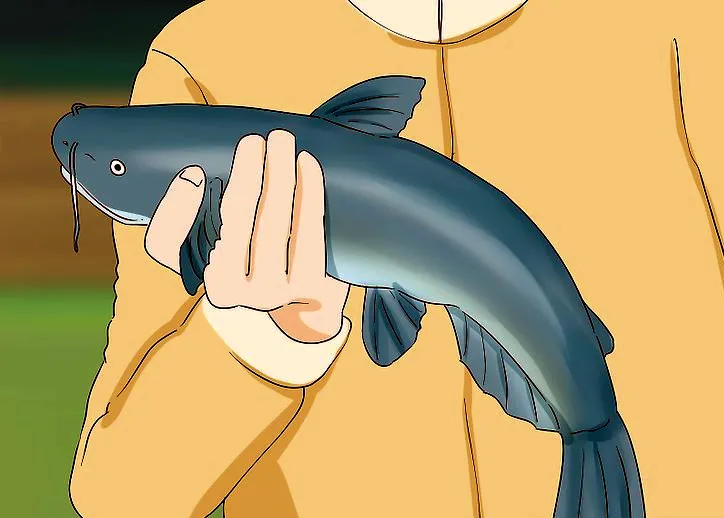
Hold the catfish firmly but gently. Use your entire hand to secure the fish’s body, applying even pressure to prevent it from slipping out. Maintain a steady grip and make small adjustments if needed, ensuring your hand stays safe from any sharp spines.
Catfish often have slippery skin covered in mud, making them a bit challenging to handle. When handling a freshly caught catfish, be prepared for sudden twists or wiggles as it tries to break free. Stay alert to avoid losing your grip
Support with other hand:
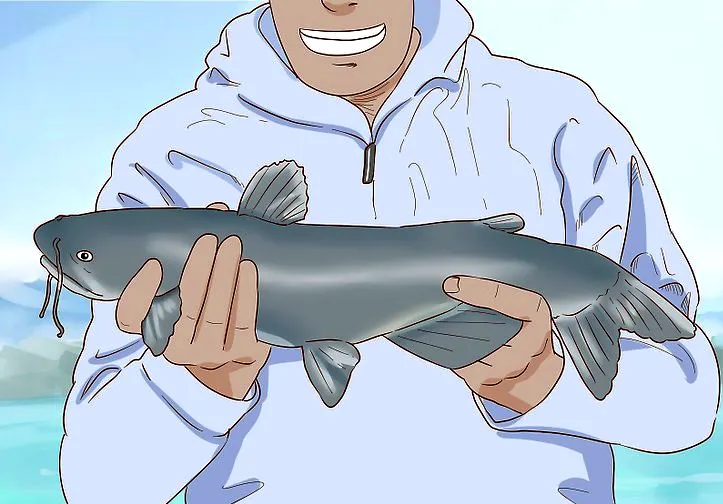
When you’re handling a larger or heavier catfish, it’s a good idea to use both hands for support. This helps distribute the weight and makes it easier to lift the fish without straining. By placing one hand under the head or behind the pectoral fins and the other hand towards the tail section, you create a two-handed grip.
This not only aids in lifting but also gives you better control, especially if the catfish starts to wiggle or thrash.
The hand supporting the tail should be positioned carefully, ensuring it’s far away from the spines to avoid any accidental pokes or injury.
Having a secure grip with both hands helps manage the weight and movement of the catfish more effectively, making the handling process safer and more controlled.
Now, it’s a time to release:
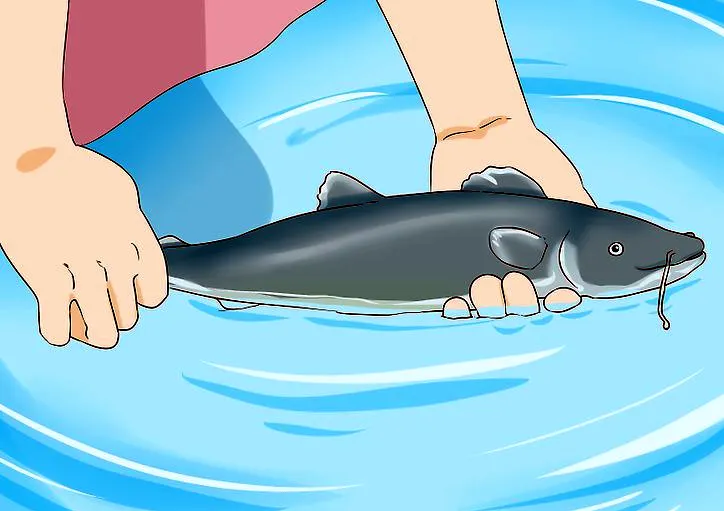
Handle the release of the catfish cautiously. Whether you’re keeping it for later or returning it to the water, be mindful.
Gradually lower the catfish close to the water’s surface. Then, in one smooth movement, gently ease your grip, ensuring your hand doesn’t slide along the fish’s back.
Instead of trying to throw or toss the catfish, allow it to smoothly slip back into the water. By releasing it gently underwater, you’re ensuring it swims away comfortably.
Since your fingers are positioned behind the spines, the catfish will swim off without causing any harm. This method keeps both you and the catfish safe during the release.
How to Hand Catfish safely
for smaller catfish:
Smaller catfish, despite their size, can pose more danger due to their smaller and sharper spines. Younger swimmers and smaller species like Madtom and young channel catfish have smaller, needle-like spines that might not look threatening but can cause more harm.
However, because of their size, they’re easier to manage if you handle them cautiously.
On the other hand, larger and older catfish, despite having spines, aren’t as risky. Their spines tend to be thicker and duller due to age, making them less likely to cause harm compared to the smaller, needle-like spines of younger catfish.
So, while the smaller ones might look innocent, it’s crucial to handle them carefully due to their sharper and more threatening spines.
Use gloves if you have sensitive skin:
Wearing gloves can be a great way to protect your hands when handling catfish. If you’re new to handling catfish or have had unpleasant experiences in the past, getting a pair of sturdy outdoor gloves can be a smart investment. These gloves are made of tough material that acts as a barrier between the catfish’s spines and your skin.
If you don’t have gloves handy, you can use a towel to cover your hand as a temporary solution while handling the fish.
However, there are some downsides to wearing gloves. They may reduce the sensitivity and delicacy of your touch, making it a bit harder to handle the fish with precision. Thicker gloves, especially, might make it challenging to maintain a firm grip on the fish.
Ultimately, while gloves can provide protection, they might compromise some dexterity and control when handling the catfish.
What should I do, if I get finned by the Catfish
Catfish, like many fish, have a layer of slimy mucus on their skin, including their fins. This slime contains bacteria, and if it gets into a wound caused by a catfish spine, it can lead to a real risk of infection. While their venom isn’t necessarily toxic, it can be very painful, especially if someone is allergic to it, potentially leading to anaphylaxis, which is a severe allergic reaction (though this is rare).
In the past, some anglers used to rub their spine wounds on the catfish’s belly, believing it relieved pain instantly. It might offer quick relief, but it significantly raises the risk of a serious infection later on. It’s not a recommended practice.
Here are the steps to take if someone gets injured by a catfish spine:
1. Immediate Actions:
- Check for respiratory distress: If the person is having trouble breathing, call for emergency medical help and perform CPR if necessary.
- Remove any barbs: Carefully remove any barbs that are embedded in the skin using tweezers. Avoid squeezing the wound.
- Clean the wound: Wash the affected area thoroughly with soap and clean water for at least 5 minutes. Rinse with fresh water.
- Soak the wound: Immerse the affected area in hot water (as hot as the person can comfortably tolerate, up to 122°F or 50°C) for 30 minutes. Adding Epsom salts to the water can help disinfect the wound.
- Apply pressure: If the wound is bleeding, apply gentle pressure with a clean cloth or gauze pad to stop the bleeding.
2. Wound Care and Monitoring:
- Don’t rub the wound with catfish slime.
- Don’t cover or tape the wound closed.
- Apply over-the-counter pain relievers: Take acetaminophen (Tylenol) or ibuprofen (Motrin, Advil) to relieve pain and swelling.
- Monitor for infection: Watch for signs of infection, such as redness, swelling, pus, or fever. If you notice any of these signs, seek medical attention immediately.
3. Seek Medical Attention:
- Seek medical attention as soon as possible: This is especially important if the wound is deep, appears infected, or continues to worsen after 24 hours. A doctor can assess the injury, provide antibiotics if necessary, and address any complications.
- Consider a tetanus shot: If you haven’t had a tetanus booster shot in the past 10 years, consult your doctor about getting one.
THINGS TO REMEMBER
Fishing for catfish can be fun, but it’s important to know they’ve got these sharp little spines that can cause some trouble, especially the smaller ones. Those tiny spines might seem less scary, but they’re actually sharper and can hurt more than the bigger ones. They’re like tiny needles and can easily poke through your skin.
Now, if you do get poked by a catfish spine, don’t panic, but do take it seriously. First off, seek some help from a doctor or medical expert, even though the toxin from these spines isn’t deadly. Sometimes, the spine might break off in your skin, and that can lead to a pretty bad infection because of the bacteria. Plus, if it’s stuck in there, it might cause a lot of bleeding.
Right after you get poked, the most important thing to do is clean the wound really well. Wash it thoroughly and use something to kill off any germs, like an antiseptic. Basic first aid is your best friend here. Once it’s clean, cover it up. It’s also a good idea to have a doctor check it out to make sure no piece of the spine is left inside and to get any antibiotics you might need.
Some folks say an old trick is to rub the wound on the catfish itself because their slimy coating might help heal it. It might have some truth to it, but it’s not a replacement for proper cleaning. Plus, if you’re fishing in dirty water, it’s not the safest idea. The best bet is to clean and treat it properly.
Handling these catfish can be tricky since you’ve got to hold them whether you’re keeping them or letting them go. There are gloves you can use that are tough enough to protect you from those spines, but they might make it harder to feel what you’re doing. Practice makes perfect here. Be careful, gentle, but also firm when handling them.
So, if you do get poked, stay calm and take care of it. Like anything, with time and practice, you’ll learn how to handle these situations better, and always remember to enjoy your time out fishing!
FAQS:
CAN WE HOLD CATFISH BY IT’S TAIL?
Yes, we can hold a catfish by the tail, especially if we want to take a picture with it. For larger catfish, grab just before the tail, making sure your fingers wrap around that narrow part for a good grip. Then, use your other hand to support the fish under its head and gills. Remember to avoid the spines near the fins while handling it.
HOW MUCH PAIN IS CAUSED BY A CATFISH STING?
The initial sting might sting a bit, but it’s bearable. What can cause more discomfort is if the wound gets infected. To avoid that, clean the area properly as mentioned earlier. Following the advice will prevent it from hurting so much that it stops you from fishing.
WHAT STEPS SHOULD YOU TAKE IF YOU GET POKED BY A CATFISH?
It’s important to take a break from fishing and clean any wounds immediately. Catfish have bacteria around their spines that can cause infections if not treated promptly. Having a small first-aid kit with antiseptic on hand while catfish fishing is a good idea to prevent complications from injuries.
IS IT ADVISABLE TO USE GLOVES WHEN DEALING WITH CATFISH?
Using a glove while handling catfish isn’t a bad idea. Personally, I’ve never felt the need to wear one. If you’re aware of where the catfish’s spines are and hold them properly, it’s quite manageable. However, keep in mind that the sharp spines of smaller catfish can sometimes poke through the material of most gloves. Nevertheless, some anglers prefer using gloves, especially when dealing with larger catfish due to their rough mouths.
CAN CHANNEL CATFISH STING YOU?
Both channel and flat-head catfish sport sharp barbed spines on their dorsal and pectoral fins. When these fish are startled or feel threatened, they raise these spines up, making them stick out at a right angle to their bodies. If these spines poke you, it’s quite painful. Additionally, the mucus covering these spines has the potential to lead to infections at the spot where you’ve been pricked
DO ALL CATFISH HAVE BARBS?
Even though they’re called catfish, not every one of them has those distinctive whisker-like barbels. What really sets these fish apart is their skull and swim bladder features.
CAN CATFISH STING CAUSE DEATH?
Catfish stings typically aren’t life-threatening but can cause a lot of pain. There isn’t a specific cure for a catfish sting, so the focus of treatment is mainly on easing the symptoms. Emotional trauma refers to the psychological impact following a highly distressing or life-endangering event.
Image Source wikihow.com
